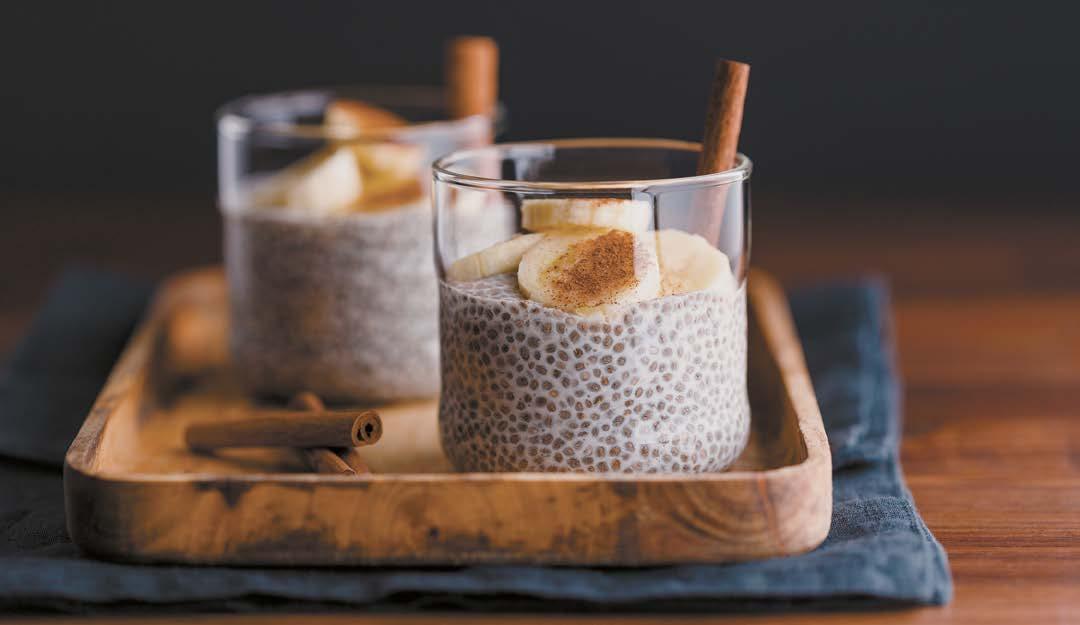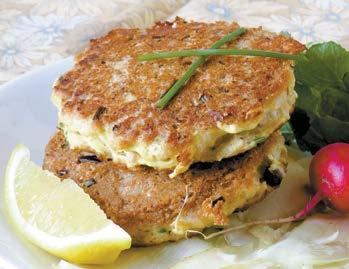
6 minute read
conscious eating
A Better Breakfast Healthy Tips and Recipes to Start the Day
by April Thompson
Advertisement
Breakfast sets the stage for the day ahead, and it can either drain or energize us, depending on the what, when and how much aspects of the meal. While health experts agree that many traditional breakfast foods can do more harm than good, delicious, healthy alternatives are within easy reach of the breakfast table.
Morning favorites like pastries, sugary cereals and pancakes, high in refined sugars and carbs, cause insulin production to spike and blood sugar levels to crash, according to David Perlmutter, an acclaimed neurologist based in Naples, Florida, and author of Grain Brain: The Surprising Truth about Wheat, Carbs, and Sugar - Your Brain’s Silent Killers. “People need to train their bodies to tap into the energy reserves within, harvesting fat for energy rather than being reliant on the next meal. A breakfast high in protein and fat will do that,” he says.
While often waiting until noon for his first meal of the day, Perlmutter frequently opts for eggs and salad drenched in an extra-virgin olive oil dressing to break the fast. Perlmutter suggests waiting 12 hours or longer between dinner and the next day’s breakfast. “Time-restricted eating”, or intermittent fasting, can have surprising health benefits, helping crank up production of the brain-derived neurotrophic factor, a powerful initiator for growth of new brain cells, and kickstart autophagy, the body’s method of cleaning out damaged cells, according to the neurologist.
A plant-based chef based in Bruges, Belgium, Julie Van den Kerchove switched from a raw, vegan diet to a mainly keto diet, low in carbohydrates, to regain energy after “hitting a wall, experiencing hormonal imbalances and nutritional deficiencies. Before, I would have green smoothies with lots of fruit and leafy greens, but would be ‘hangry’ a few hours later. Now my breakfast consists more of healthy fats and proteins, which helps me stay satisfied and energized until lunchtime. I experience more mental clarity and calmness because my blood sugar is not going up and down,” says Van den Kerchove, a blogger and author of vegan, raw-food and keto cookbooks.
A typical breakfast for her now is a chia seed pudding with a nut or coconut milk, berries, nuts and seeds with a protein powder and stevia, which is easy to prepare in advance, or a warm porridge with hemp seeds, nut butter, chia seeds and almond, hemp or coconut milk, which is high in fiber and healthy fats. “If I feel like [having] something savory, I’ll have seed crackers topped with avocado and eggs or a Mediterranean omelet,” she adds.
Teresa Fung, a professor of nutrition at Simmons University and adjunct professor at Harvard University, both in Boston, cautions about completely cutting carbs from breakfast, however. “Fruits and vegetables are important healthy sources of carbs, essential to
get enough fiber to maintain healthy gut microbiome and feed the good bacteria in your GI tract,” says Fung, who is an associate editor for The Journal of Nutrition. “Optimal morning fuel will include a good dose of protein, vitamins and minerals, fiber, antioxidants and some heart-healthy fats. It will also include a healthy source of carbs that your body can use as energy, leaving proteins to be used for protein synthesis,” says Fung, suggesting a simple, but hearty breakfast of high-fiber oatmeal or yogurt with nuts and fruit.
Like Perlmutter, Fung stresses the importance of eating during daylight hours when certain enzymes are activated. “Our bodies react to daylight even when our eyes are still closed. Eating should match up with our biological clocks, as we are daytime animals, using most of our energy in the day,” she says.
Fung notes Americans that tend to make breakfast the smallest meal of the day and dinner the largest need to better balance meal sizes rather than load up on calories late in the day.
These experts agree on the need to tune into the body’s signals for hunger and satiety, not just eating breakfast on an autopilot schedule. “If I’ve eaten a huge holiday dinner the night before, I may skip my morning meal. I’m a huge proponent in being flexible and listening to your body,” says Van den Kerchove.
C o n n e c t w i t h W a s h i n g t o n , D . C . , freelance writer April Thompson at AprilWrites.com.

Caramel Apple Cinnamon Crisp Overnight Oats
These oats are a great dessert/breakfast mix that’s delicious, but good for you, too. It’s made clean by cooking the apples using coconut sugar instead of refined white sugar and adding cinnamon and nutmeg for spice. Prep the oats by mixing all the ingredients, then make a date caramel sauce that’s healthier than any caramel sauce you can purchase from the grocery store and so luscious that you’ll fall in love with it.
For the Cinnamon Apples:
2 large Honeycrisp or Pink Lady apples, cored, peeled and diced 2 Tbsp coconut sugar ⅛ tsp cinnamon ⅛ tsp nutmeg
For the Oats:
1½ cups rolled oats 1½ cups unsweetened almond milk 2 Tbsp chia seeds 1 tsp vanilla extract ¼ tsp ground cinnamon
For the Date Caramel Sauce:
10–12 pitted dried dates ⅛ tsp sea salt ½ cup hot water, divided Healthy First Meals To make the cinnamon apples, combine the apples, coconut sugar, cinnamon and nutmeg in a saucepan, and cook over medium heat for 6 to 8 minutes until the apples are softened, but not mushy.
For the oats, combine the oats, milk, chia seeds, vanilla and cinnamon in a mixing bowl.
To make the date caramel sauce, process the dates and sea salt in a food processor until they are finely chopped. Add the water, 1 tablespoon at a time, to the dates until the mixture becomes smooth and resembles caramel. You may need to scrape down the sides of the food processor.
Spoon half of the oat mixture into the bottom of an 8-ounce jar with a lid or a sealable container, then top with the date sauce and apples. Repeat in a second jar with the remaining ingredients.
Refrigerate the oats overnight or for at least 4 hours. The oats can be enjoyed cold straight from the refrigerator or heated in the microwave for 1 to 2 minutes.
Reprinted from Clean-Eating Breakfasts and Lunches Made Simple, by Lacey Baier.
Salmon Cakes with Fennel & Parsnips For the vegetables:
½ cup fennel, shaved thin (use a mandolin slicer for thinnest slices) ¼ cup parsnips, shaved ½ Tbsp coconut oil
For the salmon cakes:
6 oz can boneless, skinless, wild-caught salmon, drained 1 egg 1 Tbsp quinoa flakes 1 Tbsp fresh chives, chopped 1 tsp capers 1 tsp lemon juice ½ Tbsp coconut oil, for frying 4 radishes with greens

Heat oil in a skillet and sauté fennel and parsnips until tender, about 7 minutes. Remove to serving plate.
In a mixing bowl, combine salmon, egg, quinoa flakes, chives, capers and lemon juice. Stir to mix until most of the large chunks of salmon are broken down.
Heat oil in a frying pan over medium heat, form salmon mixture into 2 patties and cook 4 minutes per side.
Place salmon cakes over fennel and parsnips and garnish with radishes. Serve warm.
Provided by David Perlmutter, DrPerlmutter.com.








